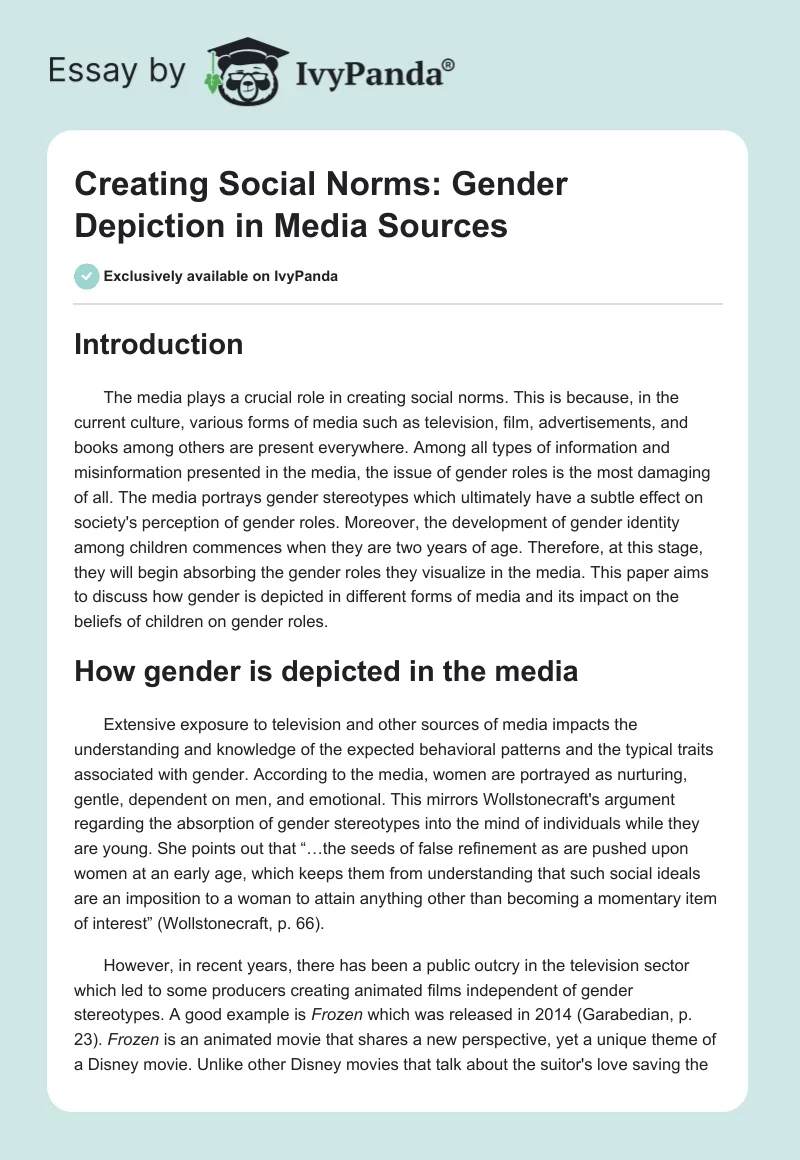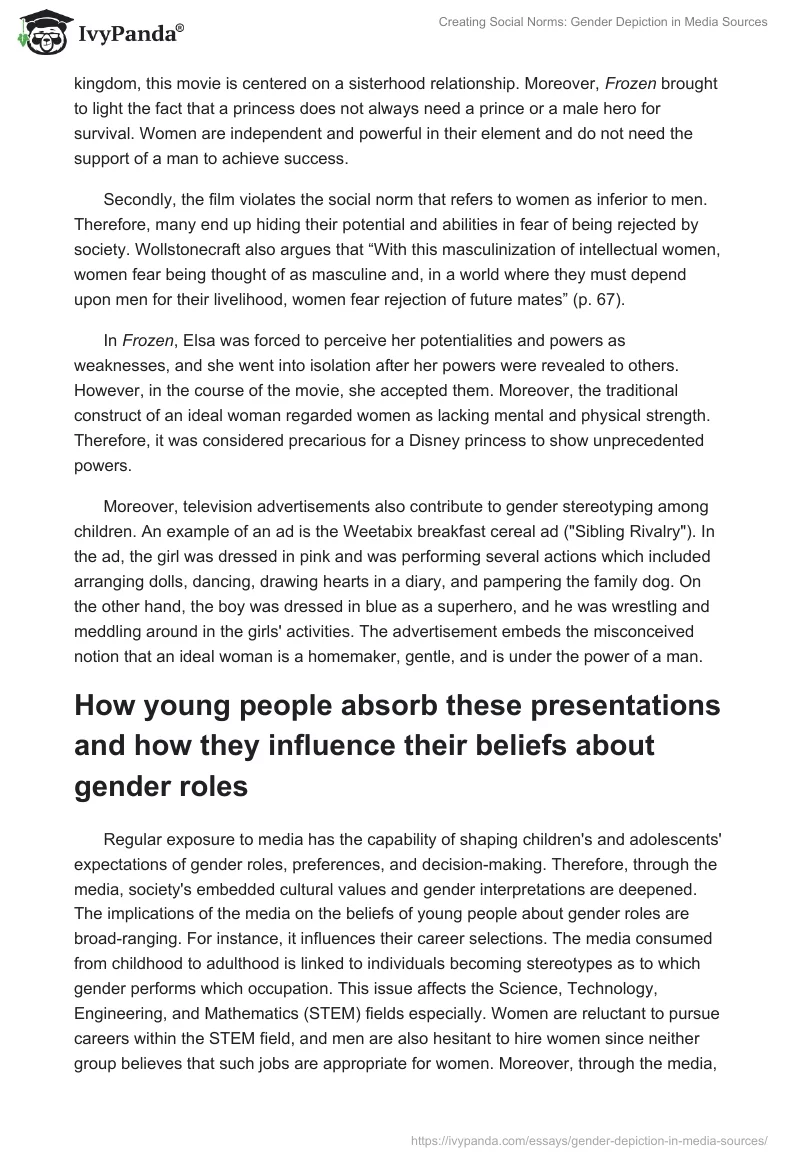Introduction
The media plays a crucial role in creating social norms. This is because, in the current culture, various forms of media such as television, film, advertisements, and books among others are present everywhere. Among all types of information and misinformation presented in the media, the issue of gender roles is the most damaging of all. The media portrays gender stereotypes which ultimately have a subtle effect on society’s perception of gender roles. Moreover, the development of gender identity among children commences when they are two years of age. Therefore, at this stage, they will begin absorbing the gender roles they visualize in the media. This paper aims to discuss how gender is depicted in different forms of media and its impact on the beliefs of children on gender roles.
How gender is depicted in the media
Extensive exposure to television and other sources of media impacts the understanding and knowledge of the expected behavioral patterns and the typical traits associated with gender. According to the media, women are portrayed as nurturing, gentle, dependent on men, and emotional. This mirrors Wollstonecraft’s argument regarding the absorption of gender stereotypes into the mind of individuals while they are young. She points out that “…the seeds of false refinement as are pushed upon women at an early age, which keeps them from understanding that such social ideals are an imposition to a woman to attain anything other than becoming a momentary item of interest” (Wollstonecraft, p. 66).
However, in recent years, there has been a public outcry in the television sector which led to some producers creating animated films independent of gender stereotypes. A good example is Frozen which was released in 2014 (Garabedian, p. 23). Frozen is an animated movie that shares a new perspective, yet a unique theme of a Disney movie. Unlike other Disney movies that talk about the suitor’s love saving the kingdom, this movie is centered on a sisterhood relationship. Moreover, Frozen brought to light the fact that a princess does not always need a prince or a male hero for survival. Women are independent and powerful in their element and do not need the support of a man to achieve success.
Secondly, the film violates the social norm that refers to women as inferior to men. Therefore, many end up hiding their potential and abilities in fear of being rejected by society. Wollstonecraft also argues that “With this masculinization of intellectual women, women fear being thought of as masculine and, in a world where they must depend upon men for their livelihood, women fear rejection of future mates” (p. 67).
In Frozen, Elsa was forced to perceive her potentialities and powers as weaknesses, and she went into isolation after her powers were revealed to others. However, in the course of the movie, she accepted them. Moreover, the traditional construct of an ideal woman regarded women as lacking mental and physical strength. Therefore, it was considered precarious for a Disney princess to show unprecedented powers.
Moreover, television advertisements also contribute to gender stereotyping among children. An example of an ad is the Weetabix breakfast cereal ad (“Sibling Rivalry”). In the ad, the girl was dressed in pink and was performing several actions which included arranging dolls, dancing, drawing hearts in a diary, and pampering the family dog. On the other hand, the boy was dressed in blue as a superhero, and he was wrestling and meddling around in the girls’ activities. The advertisement embeds the misconceived notion that an ideal woman is a homemaker, gentle, and is under the power of a man.
How young people absorb these presentations and how they influence their beliefs about gender roles
Regular exposure to media has the capability of shaping children’s and adolescents’ expectations of gender roles, preferences, and decision-making. Therefore, through the media, society’s embedded cultural values and gender interpretations are deepened. The implications of the media on the beliefs of young people about gender roles are broad-ranging. For instance, it influences their career selections. The media consumed from childhood to adulthood is linked to individuals becoming stereotypes as to which gender performs which occupation. This issue affects the Science, Technology, Engineering, and Mathematics (STEM) fields especially. Women are reluctant to pursue careers within the STEM field, and men are also hesitant to hire women since neither group believes that such jobs are appropriate for women. Moreover, through the media, personal values are nurtured. Media exposure influences the beliefs of children and adolescents regarding the skills and attributes associated with each gender. For example, children tend to associate beauty and elegance more with girls, and brilliance and intellect more with boys.
Conclusion
Despite the increasing public awareness of the need for boys and girls to live their lives independent of gender rules, content producers have been sluggish in changing the kind of media content they produce for children. Wollstonecraft once stated that “It is justice, not charity, that is wanting in the world!” This is a plead for equality and justice between both genders. The social norms perceive females as inferior to the male gender. This limits the extent to which the female gender can showcase its capabilities hence be empowered. It is time for the roles of the female gender to change, and this can be only achieved by changing the content presented in the media.
Works Cited
- Garabedian, Juliana. “Animating Gender Roles: How Disney is Redefining the Modern Princess”. James Madison Undergraduate Research Journal, vol. 2, no. 1, 2014, pp. 22-25.
- “Sibling Rivalry. Weetabix Chocolate“. YouTube, uploaded by Goldstein, 2013, Web.
- Wollstonecraft, Mary. A Vindication of the Rights of Woman. Start Classics, 2014.


